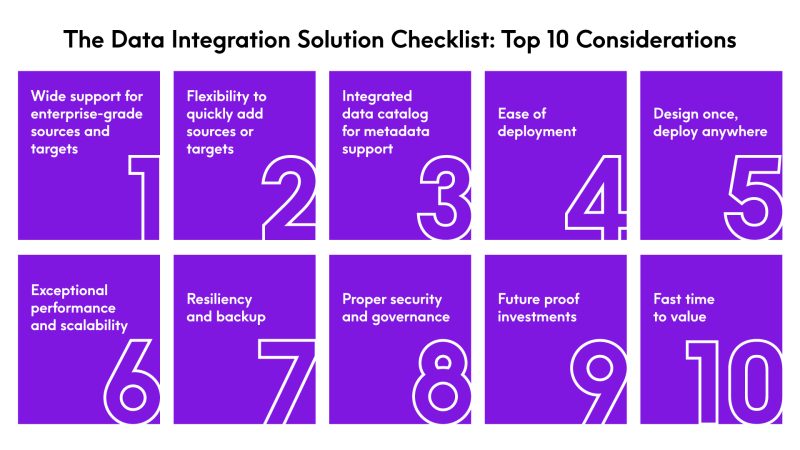
The Data Integration Solution Checklist: Top 10 Considerations

Key Takeaways:
- Data integration is vital for real-time data delivery across diverse cloud models and applications, and for leveraging technologies like generative AI.
- Successful data integration solution criteria include: offering wide-ranging support for various data sources and targets, seamless integration with existing tech stacks, easy deployment, ability to capture metadata, and capability to prescribe and monitor governance policies
- When evaluating vendors, ask about enterprise data source support, integration with current technologies, scalability, and more.
- The right data integration solution helps you streamline operations, enhance data quality, reduce costs, and make better data-driven decisions.

The world’s most innovative companies never merely stand still. They continue to seek new ways to add value and stake out a leadership position as new technologies emerge.
As enterprise technology landscapes grow more complex, the role of data integration is more critical than ever before.
Factors like a broader diversity of cloud data consumption models, a surge in the number and types of applications demanding real-time data delivery, and the all-consuming interest in leveraging generative AI (artificial intelligence) and AI models are driving the need for enterprise-grade solutions with bulletproof reliability and a proven track record of success.
If you’re in the market for a data integration solution, there are many things to consider – including the flexibility of integration solutions, the availability of a strong network of service providers, and the vendor’s reputation for thought leadership in the integration space.
With these factors and more in mind, starting the process can feel overwhelming – but not to worry. If you need to build stronger, faster, and flexible data integration, use this checklist of ten key attributes to streamline your search and find the right technology for your organization, faster.
#1. Wide support for enterprise-grade sources and targets
Large organizations with complex IT landscapes must have the capability to easily connect to a wide variety of data sources.
Whether it’s a cloud data warehouse or a mainframe, look for vendors who have a wide range of capabilities that can adapt to your changing needs. A true enterprise-grade integration solution calls for source and target connectors that can accommodate:
- VSAM files
- COBOL copybooks
- open standards like JSON
- modern platforms like Amazon Web Services (AWS), Confluent, Databricks, or Snowflake
Questions to ask each vendor:
- Which enterprise data sources and targets do you support?
- Are these sources a match for all my batch data ingest and change data capture (CDC) needs?
#2. Quickly and easily add sources or targets
Integration software should enable you to respond to new requirements and additions to your IT environment quickly and easily whenever they emerge. Whether you’re bringing a new system online or connecting an existing database with your analytics platform, the process should be simple and straightforward.
In most cases, authorized users should be able to add sources and targets at the click of a button, without custom programming.
Questions to ask each vendor:
- What’s the process for adding new sources or targets?
- How much time is required from me for this process?
#3. Integrated data catalog for metadata support
As you build out your IT ecosystem, it’s important to leverage tools that have the capabilities to support forward-looking use cases. A notable capability that achieves this is the data catalog. A data catalog is a foundational component of any data strategy, providing a go-to knowledge base of data for users across an enterprise.
A well-integrated data catalog supports the extensive discovery, access, use, and sharing of both technical and business metadata – automating and improving your data integration and operations tasks. It synthesizes all the metadata around your organization’s data assets and arranges the information into a simple, easy-to-understand format.
Additional data integrity capabilities to look for include those that support data governance mandates – like data quality, data lineage, and policy enforcement – while handling data for meeting specific use cases, including master data management.
Questions to ask each vendor:
- Does your data integration solution provide access to the metadata?
- If so, how do you combine that metadata with other data across the enterprise?
#4. Ease of deployment
An experienced vendor should offer solutions that enable rapid deployment, so that it never slows down your operations.
Questions to ask each vendor:
- What can I expect around deployment and support?
- Can you provide references and proof points?
#5. Design once, deploy anywhere approach
Look for vendors with a record of providing customers with a streamlined path to new platforms. The software should support various platforms and enable movement between platforms without the need for manual intervention. You should also be able to deploy data pipelines anywhere your data lives, whether it be on-premises, public cloud, private cloud, multi-cloud, or hybrid environment.
Questions to ask each vendor:
- How much work is involved to move from one platform to another?
- Can you support hybrid and multi-cloud environments?
- What kind of service disruptions should I expect?
Read the eBook
Buyer’s Guide and Checklist for Data Integration
This checklist will help you evaluate data integration vendors and software that will help you meet the challenges of the new data integration paradigm.
#6. Exceptional performance and scalability
As enterprises grow and an increasing volume of both structured and unstructured data becomes available, scalability is critical.
Data enrichment from third-party datasets further adds to the value of existing assets and calls for increased capacity to handle large volumes of data. Look for software that scales to accommodate growing volumes of data, users, and unpredictable peak usage demands.
Questions to ask each vendor:
- How do you deliver both predictable performance and scalability?
#7. Resiliency and backup
Far too many companies have learned about the importance of resiliency the hard way. Data integration software should help you focus on your business, not your systems.
Seek out vendors with a proven track record in the enterprise space.
Questions to ask each vendor:
- How do your solutions provide data delivery resiliency and backup in the event of a service disruption?
- What kind of manual coding or tuning might be necessary to bring systems back online after a major event?
#8. Proper security and governance
Regulatory compliance and security continue to be in the spotlight. Europe’s GDPR and similar legislation worldwide underscore the vital importance of data governance.
Enterprise vendors should present clear proof of secure data transfer and integrate with leading security software products for maximum protection.
Questions to ask each vendor:
- How do your solutions keep my data secure as it moves through the data pipeline?
- What data governance controls do your solutions have in place?
#9. Future proof investments
Investing in less robust, point-to-point integration technology may save you a small amount of money in the short term. But before long, those tools can cost considerably more than their enterprise-quality counterparts.
As you add new integration points (including cloud, on-premise, or hybrid environments, for example), you’ll need to invest additional resources in managing that growing complexity. The software you select today can help to insulate you from future technology requirements and disruption without coding, tuning, or redevelopment work.
Questions to ask each vendor:
- What’s your development approach?
- Does this approach insulate me from future technology requirements and disruption, without coding, tuning, or redevelopment work?
#10. Fast time to value
Implementation of data integration software shouldn’t add more complexity to your technology landscape. Deployments shouldn’t require specialized skills or become a drain on organizational resources. Explore each vendor’s offering enough to gain a thorough understanding of the processes and their impact on your timeline.
Questions to ask each vendor:
- What does the implementation and deployment process look like?
- With these processes, how fast will I achieve my goals?
Taking Action: Find the Best Data Integration Solution for Your Needs
Does this list have you feeling ready to zero in on a short list of the best vendors and tools to serve your needs?
If your organization needs to build stronger, faster, and more flexible integration, the time to start is now – and we’d love to talk with you about your project. With our unmatched expertise across data domains, disciplines, and platforms, businesses like yours are empowered to make fast, confident decisions based on data that’s trustworthy and contextually rich.
It’s time to reduce costs, increase quality, and unleash your data’s value. Contact us to talk about your needs, and dive even deeper with our eBook: Buyer’s Guide and Checklist for Data Integration.


